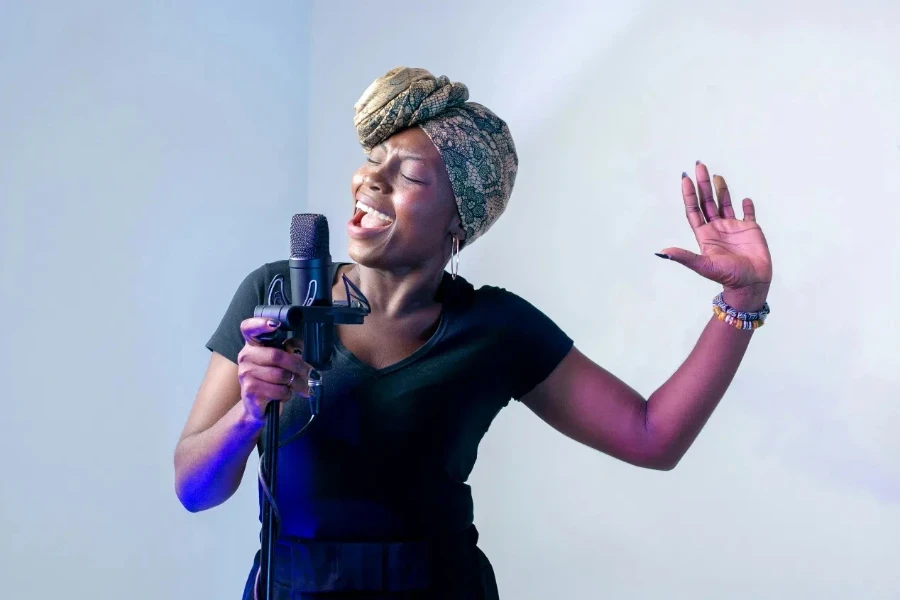As of late 2024, the microphone market is booming, with a 6.99% CAGR projected through 2030. This surge is driven by innovations in voice recognition and the rising popularity of video content creation. In this article, we explore the evolving landscape of microphones for singing, providing business buyers with essential insights to navigate this dynamic market.
Table of Contents:
– Market Overview of Microphones for Singing
– Detailed Introduction and Analysis of this Market
– Key Factors When Selecting Microphones For Singing
– Latest Technology Features in Microphones for Singing
– Final Thoughts
Market Overview of Microphones for Singing

The global market for microphones used in singing has seen notable growth in recent years. In 2024, the microphones market size reached USD 2.97 billion, increasing from USD 2.79 billion in 2023, with a compound annual growth rate (CAGR) of 6.99%. By 2030, projections estimate the market will reach USD 4.48 billion. This growth is fueled by the rising adoption of smartphones and portable electronics, advancements in voice recognition software, and the increasing popularity of video content creation on social media platforms.
In 2023, the Asia-Pacific region led the market, driven by established manufacturing facilities and strong domestic demand. North America followed as the second-largest market, significantly supported by the entertainment industry, particularly in music production and podcasting. The European market, especially in countries like Germany, France, and the UK, also showed strong demand due to vibrant media industries.
Key players in the market include companies such as Sonion, Georg Neumann GmbH, and AKG Acoustics. These firms are at the forefront of innovation, integrating technologies like artificial intelligence (AI) for automatic gain control and voice recognition. Market dynamics are influenced by shifts in consumer behavior, economic conditions, and technological advancements.
Detailed Introduction and Analysis of this Market

Key Performance Benchmarks and Market Share Dynamics
Digital microphones have gained traction due to their accuracy in sound reproduction and reduced noise interference. The market is divided into wired and wireless microphones, with wireless options becoming more popular for their mobility and convenience. Market share dynamics are affected by the widespread use of mobile phones and laptops, which often include integrated microphone technologies.
Economic Influences and Consumer Behavior Shifts
Rising disposable incomes and the growth of the middle class in developing countries have led to increased spending on high-quality audio equipment. Consumers now prefer personalized and immersive audio experiences, boosting demand for advanced microphone technologies. Seasonal demand patterns also impact sales, with peaks during major festivals and events.
Distribution Channel Preferences and Recent Innovations
Retailers and wholesalers tend to purchase directly from manufacturers to ensure quality and authenticity. Online distribution channels have grown significantly due to their convenience and variety of options for consumers. Recent innovations include 3D audio technology for immersive sound and beamforming technology for selective signal reception.
Key Factors When Selecting Microphones For Singing

Choosing the right microphone for singing is crucial for achieving optimal vocal performance. Several factors must be considered to ensure the microphone meets the singer’s specific needs and the environment. Below are the essential aspects to consider:
1. Type of Microphone
Microphones come in various types, each suited for different applications. The main types are dynamic, condenser, and ribbon microphones.
Dynamic Microphones
Dynamic microphones, like the Shure SM58, are known for their durability and versatility. They are often used in live performances due to their ability to handle high sound pressure levels without distortion. Their rugged construction makes them ideal for on-stage use where they might face rough handling.
Dynamic microphones are also more affordable, making them accessible to many users. Their cardioid pickup pattern helps isolate the singer’s voice from background noise, providing a clear and focused sound. However, they may not capture the same level of detail as condenser microphones.
Condenser Microphones
Condenser microphones, such as the Neumann U87, are preferred in studios for their sensitivity and accuracy. They capture a wide frequency range and provide detailed, natural sound, ideal for recording vocals. Condenser microphones require phantom power, typically supplied by a mixing console or an external power source.
These microphones are more sensitive to loud sounds and can be more fragile than dynamic microphones. They often come with multiple pickup patterns, allowing greater flexibility in recording different vocal styles and environments. The higher cost reflects their superior sound quality and advanced features.
Ribbon Microphones
Ribbon microphones, like the Royer R-121, offer a vintage sound that is smooth and warm. They are less common but highly valued in certain recording situations. Ribbon microphones are bi-directional, picking up sound equally from the front and back while rejecting sound from the sides.
These microphones are delicate and can be damaged by high sound pressure levels or improper handling. They do not require phantom power but can benefit from a high-quality preamp for the best performance. Ribbon microphones are often used to capture the nuances of a singer’s voice, providing a unique and rich sound.
2. Polar Pattern
The polar pattern of a microphone determines how it picks up sound from different directions. The main polar patterns are cardioid, super-cardioid, omni-directional, and figure-8.
Cardioid
Cardioid microphones, such as the Audio-Technica AT2020, pick up sound from the front while rejecting sound from the sides and rear. This makes them ideal for isolating the singer’s voice from other instruments and background noise. They are commonly used in both live and studio settings.
Super-Cardioid
Super-cardioid microphones, like the Sennheiser MKH 8050, have a narrower pickup pattern than cardioid microphones, providing even greater isolation from ambient noise. This can be advantageous in noisy environments or when recording multiple singers in close proximity. However, they are more sensitive to sound coming from the rear.
Omni-Directional
Omni-directional microphones, such as the Earthworks QTC40, pick up sound equally from all directions. They are useful in controlled studio environments where the goal is to capture a natural and ambient sound. Omni-directional microphones are less affected by the proximity effect, making them suitable for recording vocals at varying distances.
Figure-8
Figure-8 microphones, like the Sennheiser MKH 8030, capture sound from the front and back while rejecting sound from the sides. This polar pattern is ideal for stereo recording techniques such as Mid-Side (M-S) and Blumlein. Figure-8 microphones are also useful for recording vocal duets or capturing room ambience.
3. Frequency Response
The frequency response of a microphone indicates the range of frequencies it can accurately reproduce. A flat frequency response is desirable for a natural and transparent sound, while tailored frequency responses can enhance certain vocal characteristics.
Flat Frequency Response
Microphones with a flat frequency response, such as the Shure KSM32, provide an accurate and uncolored representation of the singer’s voice. This is ideal for studio recordings where the goal is to capture the true sound of the vocalist without any coloration.
Tailored Frequency Response
Some microphones, like the Shure Beta 58A, have a tailored frequency response that boosts certain frequencies to enhance vocal clarity and presence. This can be beneficial in live performances where vocals need to cut through the mix. The tailored response can also help to reduce feedback and improve intelligibility.
4. Sensitivity and SPL Handling
The sensitivity of a microphone determines how well it can pick up quiet sounds, while the maximum Sound Pressure Level (SPL) handling indicates how loud a sound it can capture without distortion.
Sensitivity
High-sensitivity microphones, such as the AKG C414, are capable of capturing subtle nuances and quiet passages in a vocal performance. This makes them ideal for studio recordings where detail and precision are paramount. However, they may also pick up unwanted background noise if not used in a controlled environment.
SPL Handling
Microphones with high SPL handling, like the Electro-Voice RE20, can capture loud sounds without distortion. This is important for singers with powerful voices or when the microphone is used close to the mouth. High SPL handling ensures that the microphone can maintain clarity and fidelity even at high volumes.
5. Build Quality and Durability
The build quality and durability of a microphone are important considerations, especially for live performances and touring.
Rugged Construction
Microphones designed for live use, such as the Shure SM58, are built to withstand rough handling and the rigors of touring. They often feature reinforced grilles and shock-mounted capsules to protect against drops and impacts.
Studio-Grade Construction
Studio microphones, like the Neumann TLM 103, are crafted with precision and high-quality materials to ensure optimal performance and longevity. While they may be more delicate than live microphones, their construction is designed to provide the best possible sound quality in a controlled environment.
Latest Technology Features in Microphones for Singing

Advancements in microphone technology have introduced new features that enhance performance and versatility for singers.
1. Wireless Capabilities
Wireless microphones, such as the Sennheiser EW 500 G4, offer freedom of movement on stage without the constraints of cables. Modern wireless systems provide reliable connectivity and high-quality sound with minimal latency. They are essential for dynamic stage performances and interactive shows.
2. Digital Signal Processing (DSP)
Microphones with built-in DSP, like the Shure MV7, offer real-time audio processing capabilities. DSP can include features such as noise reduction, equalization, and compression, allowing singers to achieve a polished sound without external equipment. This technology is particularly useful for live streaming and podcasting.
3. USB Connectivity
USB microphones, such as the Audio-Technica AT2020USB+, provide a direct connection to computers and mobile devices. This simplifies the recording process for home studios and mobile setups. USB microphones often include built-in preamps and headphone outputs for real-time monitoring.
4. Modular Design
Modular microphones, like the Sennheiser MKH 8000 series, offer interchangeable capsules and accessories to adapt to different recording situations. This flexibility allows users to customize their microphone setup for specific vocal styles and environments.
5. Smart Integration
Smart microphones, such as the AKG Lyra, integrate with digital assistants and smart home systems. These microphones can be controlled via voice commands and offer seamless integration with other smart devices. This technology enhances convenience and expands the functionality of the microphone.
Proper maintenance and care are essential to ensure the longevity and optimal performance of microphones for singing. The warranty and after-sales service provided by the manufacturer are also important considerations when purchasing a microphone for singing.
Final Thoughts

Selecting the right microphone for singing involves careful consideration of various factors, including the type of microphone, polar pattern, frequency response, sensitivity, build quality, and latest technology features. By understanding these aspects, you can make informed decisions to find the best microphone for your needs and budget.




